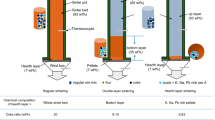The purpose of this study was to investigate the reduction behavior of cold-bonded composite pellets produced from low-grade hematite iron ore using molasses solution at various concentrations, as well as their physical and chemical properties. Direct-Reduction Iron (DRI) technology makes it possible to assess low-grade iron ores and convert them into scrap at facilities that have electric arc furnaces. The reductant used was coke with fixed carbon of 86.04%. The alkalinity rate was adjusted to 0.7 by adding calcium carbonate. In the composite pellets produced, the 300 N/pellet compression strength recommended in the literature was achieved with a Fetot/Cfix ratio of 2.5 and 3 using a 50% concentrated molasses solution. Composite pellets prepared with a Fetot/Cfix ratio of 3.5 using a 40% concentrated molasses solution reached a compression strength of 496 N/pellet. The porosity is inversely proportional to the increase in compression strength and binder concentration. Reduction experiments were conducted by applying different temperatures and durations to samples possessing optimum conditions for each Fetot/Cfix ratio: the best result was achieved with a 88% reduction rate in composite pellets with a Fetot/Cfix ratio of 3.5 at the end of 1 h. Pig iron nuggets were characterized using an optical microscopy (LOM) and a scanning electron microscopy (SEM) with energy dispersive spectroscopy (EDS).










Similar content being viewed by others
References
E. Cevik, Investigation of Molasses Effect on Reduction Behaviour of Cold-Bonded Composite Pellets: Dissertation for Master’s Degree, Graduate School of Natural and Applied Sciences, Karabuk University, Karabuk (2011).
R. Sah and K. Dutta “Effects of binder on the properties of iron ore-coal composite pellets,” Miner. Process. Extr. Metall., 31, No. 2, 73–85 (2010).
A. Ghosh, M. Mungolge, N. Gupta, et al., “A preliminary study of ınfluence of atmosphere on reduction behavior of iron ore-coal composite pellets.” ISIJ Int., 39, No. 8, 829–831 (1999).
M. B. Mourao and C. Takano, “Self-reducing pellets for ironmaking: reaction rate and processing,” Miner. Process. Extr. Metall., 24, No. 3, 183–202 (2003).
V. M. Chizhikova, R. M. Vainshtein, S. N. Zorin, et al., “Production of iron ore pellets with organic binders,” Metallurgist, 47, No. 3–4, 141–146 (2003).
B. B. Agrawal, K. K. Prasad, S. B. Sarkar, et al., “Cold bonded ore–coal composite pellets for sponge ironmaking. Part 1. Laboratory scale development,” Ironmak. Steelmak., 27, No. 6, 421–425 (2000).
G. Qıu, Z. Jiang, T. Huang, et al., “Characterization of preparing cold bonded pellets for direct reduction using an organic binder,” ISIJ Int., 43, No. 1, 20–25 (2003).
B. Birol, Y. E. Benkli, M. Boyrazlı, et al., “Investıgatıon of the effect of bınder type on the strength of cold bonded composıte pellets,” 5th Int. Adv. Technol. Symp., Karabuk, Turkey (2009), pp. 1210–1214.
D. K. Dutta, D. Bordoloi, and P. Borthakur, “Investigation on reduction of cement binder in cold bonded pelletization of iron ore fines,” Int. J. Miner. Process, 49, No. 1–2, 97–105 (1997).
R. Robinson, “High temperature properties of by-product cold bonded pellets containing blast furnace flue dust,” Thermochim. Acta, 432, No. 1, 112–123 (2005).
B. Anameric and S. K. Kawatra, “The microstructure of the pig iron nuggets,” ISIJ Int., 47, No. 1, 53–61 (2007).
K. S. Singh and T. Krishnan, Reduction Kinetics of Iron Ore Pellets and the Effect of Binders: Dissertation for Master’s Degree, Department of Metallurgical and Materials Engineering, National Institute of Technology, Rourkela (2008).
I. Kaboyashi,Y. Tanigaki, and A. Uragami, “A new process to produce iron directly from fine ore and coal,” Ironmak. Conf. Proc., Osaka (2001), pp. 649–657.
B. Birol, Production of Composite Pellets and Iron Nuggets from Divrigi Pconcentrate: Dissertation for Master’s Degree, Graduate School of Natural and Applied Sciences, Yıldız Technical University, Istanbul (2007).
S. Nath, Study of Reduction Kof Iron Ore Pellets by Non-Coking Coals: Dissertation for Master’s Degree, Department of Metallurgical and Materials Engineering, National Institute of Technology (2009).
N. M. Sial, “Fuels,” United States Patent, 4892560, 1990-09-01.
Author information
Authors and Affiliations
Corresponding author
Rights and permissions
About this article
Cite this article
Cevik, E., Ahlatci, H. & Sun, Y. Characterization and Reduction Behavior of Cold-Bonded Composite Pellets for Direct Reduction Using an Organic Binder. Metallurgist 57, 468–477 (2013). https://doi.org/10.1007/s11015-013-9757-2
Published:
Issue Date:
DOI: https://doi.org/10.1007/s11015-013-9757-2




